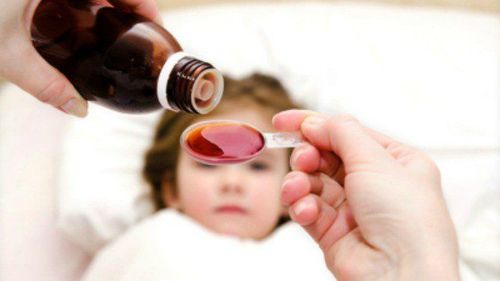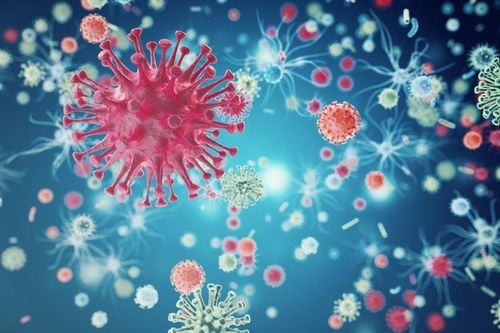This is an automatically translated article.
The article was professionally consulted by Doctor Tran Mai Phuong - Pediatrician - Neonatologist - Department of Pediatrics - Neonatology, Vinmec Central Park International General HospitalRespiratory syncytial virus is one of the most common causes of viral respiratory infections, affecting the lungs and respiratory tract in both adults and children. The illness can present as mild as the common cold, but in severe cases may require hospitalization.
1. What is respiratory syncytial virus?
Respiratory syncytial virus is a highly contagious viral source in the community. The organ most commonly affected is the respiratory system. And this is the source of infection that causes uncomfortable symptoms on the respiratory tract with different degrees. Symptoms of respiratory syncytial virus infection can be mild, like a cold. However, if the lower respiratory tract is affected, the person will develop bronchiolitis and pneumonia.
Most children are exposed to respiratory syncytial virus at least once from birth until they are 2 years old. Statistics show that 1 to 2% of infants under 6 months of age with respiratory syncytial virus infection require hospitalization. In adults, they tend to affect older adults, people with chronic medical conditions.
2. What are the characteristics of respiratory syncytial virus?
The respiratory syncytial virus is highly contagious and the route of transmission is through droplets. When an infected person coughs or sneezes, respiratory secretions containing the virus are spread into the air. Respiratory syncytial virus can survive for hours on surfaces such as countertops, hands and clothes, making the virus easily transmitted from person to person.A perfectly healthy normal person can have symptoms for 3 to 8 days. However, in infants, young children, and immunocompromised individuals, respiratory syncytial virus can cause illness for up to 4 weeks.
People at high risk for serious complications or serious symptoms include:
Premature babies Children under 2 years old Elderly Adults or children with congenital immunodeficiency People with congenital heart disease or chronic lung disease People with other respiratory conditions, such as asthma Infections are highly contagious among family members or children in daycare or school.

Trẻ sinh non thuộc đối tượng có nguy cơ cao bị biến chứng
3. What are the symptoms of respiratory syncytial virus?
Symptoms of respiratory syncytial virus infection usually develop 3 to 8 days after direct or indirect exposure to the virus.Runny nose Cough Sneezing Sore throat Headache Loss of appetite or poor appetite Fever Wheezing, shortness of breath, and shortness of breath Short, shallow and rapid breathing Pale skin on lips Slow, lethargic or lethargic
4. How to diagnose respiratory syncytial virus disease?
When having the above symptoms, the patient or young child who comes to visit will be examined by the doctor, taking the medical history, related history and general physical examination. In particular, it is important to pay attention to lung injuries as well as measure blood oxygenation status by hand-held devices, in order to quickly approach the possibility of respiratory failure and need timely treatment.
From a clinical perspective, doctors often do not ask to distinguish between respiratory syncytial virus and other common cold viruses. However, if the pathology occurs in infants or the above-mentioned risk subjects, it is necessary to be hospitalized for convenient monitoring as well as performing diagnostic tests for respiratory syncytial virus. help rule out other infections and select the right treatment modality.
Additional tests to do are blood tests, chest X-ray and cultures of sputum, nasal secretions, or oropharyngeal swabs.

Bác sĩ lấy dịch phết vùng hầu họng làm xét nghiệm
5. Prevention of respiratory syncytial virus infection
The best way to prevent the infection and spread of respiratory syncytial virus is to adhere to good personal and environmental hygiene practices.Wash your hands: Always wash your hands after coming in contact with anyone with cold-like symptoms and before coming into contact with children. If parents or carers follow it right, this can also help children learn the importance of hand washing. Wipe clean surfaces: The risk of spreading respiratory syncytial virus can be reduced by regularly cleaning surfaces such as toys, furniture, and handles. Coughs and sneezes: Children need to be taught how to cover their coughs or sneezes from the age of two, preferably using a handkerchief or sneeze into their elbow, to avoid getting droplets on their hands. Personal tools: Encourage each family member, children in the same class to have separate personal tools such as cups, dishes, napkins, face towels... Limit contact with people have cold-like symptoms, avoid crowded places Avoid smoking and exposure to secondhand smoke anti-RSV (palivizumab), especially in the autumn-winter months. In summary, respiratory syncytial virus infection is a fairly common causative agent, most of which are acquired by children before school age. However, while the majority of cases are mild and self-resolving at home, a few lead to serious complications, especially those at risk. Accordingly, each parent needs to know how to take care of and monitor danger signs for their children so that they can seek timely medical intervention support.
To prevent children from being infected with viruses, parents should add some supporting foods containing lysine, essential micro-minerals and vitamins such as zinc, chromium, selenium, B vitamins,... fully meet the nutritional needs while supporting the immune system, enhancing resistance, reducing the risk of upper respiratory tract infections, bronchitis, flu.
Lysine is very necessary for the development of children, Lysine promotes the production of digestive enzymes to stimulate children to eat better and digest easily and effectively, increase food metabolism, maximize absorption of nutrients. food nutrition. Increasing lysine for babies also helps the body create antibodies, develop resistance to help reduce cough and thin sputum in children.
Parents can learn more:
Why do you need to supplement Lysine for your baby?
Please regularly visit Vinmec.com website and update useful information to take care of your baby and family.













